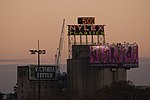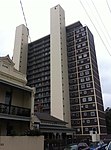Walsh Street House
Architecture of MelbourneHouses completed in 1958Houses in MelbourneUse Australian English from August 2018

The Walsh Street House, also known as the Boyd House II, is a family home in Walsh Street, South Yarra, Victoria, Melbourne, Australia, designed by Robin Boyd in 1958, which the Boyds moved into a year later. Robin Boyd was known not only as an architect but also an architectural writer, educator and commentator. Born in 1919, as a member of the Boyd family, he came from a creative family background of sculptors, painters and architects. He and his wife Patricia occupied the South Yarra home with their two daughters.
Excerpt from the Wikipedia article Walsh Street House (License: CC BY-SA 3.0, Authors, Images).Walsh Street House
Walsh Street, Melbourne South Yarra
Geographical coordinates (GPS) Address Nearby Places Show on map
Geographical coordinates (GPS)
| Latitude | Longitude |
|---|---|
| N -37.8313 ° | E 144.9864 ° |
Address
Wildfell
Walsh Street
3141 Melbourne, South Yarra
Victoria, Australia
Open on Google Maps








